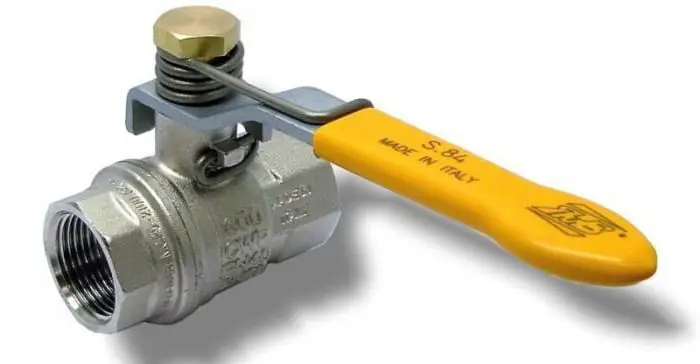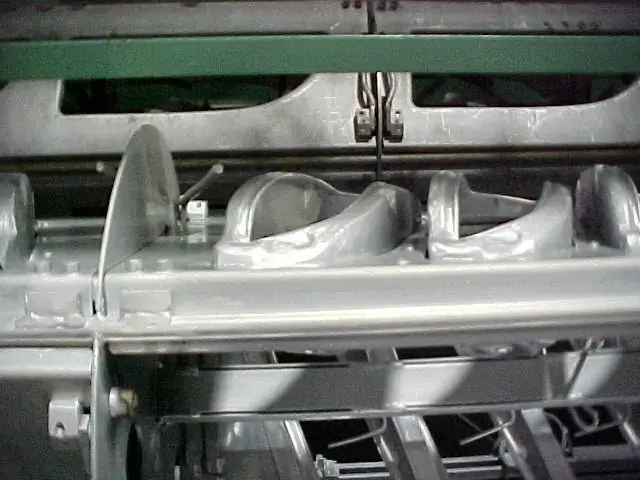2026 Author: Howard Calhoun | [email protected]. Last modified: 2025-01-24 13:10:47
Modification of various structures, parts and functional elements is often carried out by completely changing the structure of materials. For this, means of deep thermal, plasma and chemical treatment are used. But there is also a wide segment of methods for changing operational properties due to external coatings. Such methods include vacuum metallization, thanks to which it is possible to improve the decorative, conductive, reflective and other characteristics of materials.

Technology overview
The essence of the method is to spray metal particles on the work surface. The process of formation of a new coating occurs due to the evaporation of donor metals in a vacuum. The technological cycle implies the implementation of several stages of structural change of the target base and coating elements. In particular, the processes of evaporation, condensation, absorption and crystallization are distinguished. The key procedure can be called the interaction of metal particles with the surface in a special gaseous environment. At this stage, vacuum metallization technology ensures the processes of diffusion and attachment of particles to the structure of the workpiece. On theoutput, depending on the spraying modes, coating characteristics and type of workpiece, you can get a variety of effects. Modern technical means make it possible not only to improve the individual performance of the product, but also to differentiate the surface properties in individual areas with high accuracy.
Applied equipment
There are three main groups of machines used for this technology. This equipment is continuous, semi-continuous and intermittent. Accordingly, they differ on the basis of the general organization of the processing process. Units with continuous operation are often used in mass production, where in-line vacuum metallization is required. Equipment of this type can be single or multi-chamber. In the first case, the units are oriented towards the implementation of direct metallization. Multi-chamber models also provide for the possibility of implementing additional procedures - primary preparation of the product, control, heat treatment, etc. This approach allows you to optimize the manufacturing process. Machines for batch and semi-continuous plating generally have one main chamber. It is precisely because of the irregularity of production that they are used for a specific procedure, and the preparatory operations and the same quality control are carried out in a separate order - sometimes in manual mode without automated lines. Now it is worth considering in more detail what nodes such aggregates consist of.

Arrangement of machines for metallization
Besides the main chamber, where the deposition processes take place, the equipment includes many auxiliary systems and functional components. First of all, it is worth highlighting directly the sources of the sprayed material, the communications of which are associated with the gas distribution complex. In order for the vacuum metallization plant to provide the parameters necessary for a particular processing task, the spraying feed channels with regulators allow, in particular, to adjust the temperature level, flow direction speed and volumes. In particular, this infrastructure is formed by leaks, pumps, valves, flange elements and other fittings.
In modern installations for the same regulation of operating parameters, sensors are used, connected to the microprocessor unit. Taking into account the given requirements and fixing the current actual values, the equipment can correct the processing modes without the participation of the operator. Also, to facilitate the operation processes, the equipment is supplemented with in-chamber cleaning and calibration systems. Thanks to such equipment, the repair of vacuum metallization of the machine is simplified, since constant and timely cleaning minimizes the risks of overloading air motors, manipulators and communication circuits. The latter are completely considered as a consumable part, the replacement of which in continuous units is carried out as part of a regular maintenance procedure.

Target materials for metallization
First of all, metal blanks are subjected to the procedure,which can be made including special alloys. An additional coating is required to provide an anti-corrosion layer, improve the quality of electrical wiring, or change decorative properties. In recent years, vacuum metallization has been increasingly used in relation to polymer products. This process has its own specifics, due to the characteristics of the structure of objects of this kind. Less commonly, the technology is used for products that have low hardness. This applies to wood and some synthetic materials.
Features of metallization of plastics
Spraying on the surface of plastic parts can also change its electrical, physical and chemical properties. Often, metallization is also used as a means of improving the optical qualities of such blanks. The main problem in performing such operations is the process of intense thermal evaporation, which inevitably puts pressure on the particle flows spraying the surface of the element. Therefore, special modes of regulation of the diffusion of the base material and the consumed mass are required.
Has its own specifics and vacuum metallization of plastics, characterized by a rigid structure. In this case, the presence of protective and priming varnishes will matter. To maintain a sufficient level of adhesion to overcome the barriers of these films, it may be necessary to increase the energy of thermal action. But here again there is a problem with the risks of destruction of the plastic structure under the influence of heat flows. As a result, in order to remove excessstresses in the working environment, modifying components are introduced, such as plasticizers and solvents, which make it possible to keep the shape of the workpiece in an optimal state, regardless of the temperature regime.
Features of processing film materials

Technologies for the manufacture of packaging materials include the use of metallization for PET films. This process provides aluminization of the surface, due to which the workpiece is endowed with higher strength and resistance to external influences. Depending on the processing parameters and the final requirements for the coating, different methods of heat removal can be applied. Because the film is temperature sensitive, an additional deposition procedure is introduced. As in the case of plastics, it allows you to adjust the thermal balance, maintaining an optimal environment for the workpiece. The thickness of films that are processed by the method of vacuum roll metallization can be from 3 to 50 microns. Technologies are gradually being introduced that provide similar coatings on the surfaces of materials with a thickness of 0.9 microns, but for the most part this is still only an experimental practice.
Metallization of reflectors
This is also a separate direction of using metallization. The target object in this case is car headlights. Their design provides for the presence of reflectors, which eventually lose their performance - fade, rust and, as a result, become unusable. In addition, even a new headlightcan be accidentally damaged, which will require its repair and restoration. It is precisely this task that the vacuum metallization of reflectors is focused on, which ensures wear-resistant deposition on a mirror surface. Filling the outer structure with metallized particles, on the one hand, eliminates minor defects, and on the other hand, acts as a protective coating, preventing possible damage in the future.

Organization of the process at home
Without special equipment, surface chemical coating technology can be applied, but for vacuum processing, an appropriate chamber is required in any case. At the first stage, the workpiece itself is prepared - it should be cleaned, degreased and, if necessary, sanded. Next, the object is placed in a vacuum metallization chamber. With your own hands, you can also make special equipment on rails from profile elements. This will be a convenient way to load and unload material if you plan to process it on a regular basis. As a source of metallization particles, so-called blanks are used - from aluminum, brass, copper, etc. After that, the chamber is adjusted to the optimal processing mode and the deposition process begins. The finished product immediately after metallization can be manually coated with secondary protective coatings based on lacquers.
Positive feedback on technology
The method has many positive qualities that are noted by users of finished products in various fields. In particular, it refers tohigh protective properties of the coating, which prevents the processes of corrosion and mechanical destruction of the base. Ordinary consumers of products that have been subjected to vacuum metallization in order to improve or change their decorative qualities also respond positively. Experts also emphasize the environmental safety of the technology.

Negative reviews
The disadvantages of this method of processing products include the complexity of the technical organization of the process and the high requirements for preparatory measures for the workpiece. And this is not to mention the use of high-tech equipment. Only with its help you can get high-quality spraying. Cost is also on the list of disadvantages of vacuum plating. The price of processing one element can be 5-10 thousand rubles. depending on the area of the target area and the thickness of the coating. Another thing is that serial plating reduces the cost of an individual product.
In closing

Changing the technical, physical and decorative properties of certain materials expands the possibilities of their further application. The development of the vacuum metallization method led to the emergence of special areas of processing with a focus on specific performance. Technologists are also working on simplifying the deposition process itself, which is already manifested today in the form of equipment downsizing and post-processing procedures. As for the application of the technique at home, this is the mosta problematic method of coverage, as it requires the performer to have special skills, not to mention technical means. On the other hand, more affordable spraying methods do not allow obtaining coatings of the same quality - whether it be a protective layer or decorative styling.
Recommended:
Ball check valve: description, specifications, device and reviews

The creators of piping systems expected that water or any other product would move in one direction. But practice shows that there are exceptions. To avoid emergency situations, if the flow goes the other way, a check valve or one of its varieties is used in the pipelines - a ball valve
Vacuum rubber: description and photo

Currently, the technological process of creating a variety of parts and assemblies has advanced quite a lot. In order to produce quality seals, which are required in many products, vacuum rubber is used
Trigger device: description and reviews

Trigger device: characteristics, types, features, operation, device. Trigger device: description, photo, reviews
Tractor MTZ-1221: description, specifications, device, diagram and reviews

The MTZ-1221 tractor is a reliable, economical and productive model that is very popular with farmers in our country. This technique was designed mainly for performing agricultural work of various kinds. It is also often used in construction and utilities
What is chemical metallization? Do-it-yourself chemical metallization

Chemical plating is a process called chromium plating. It is based on the reaction of the silver mirror. This effect allows you to achieve a brilliant coating on the surface of the product

